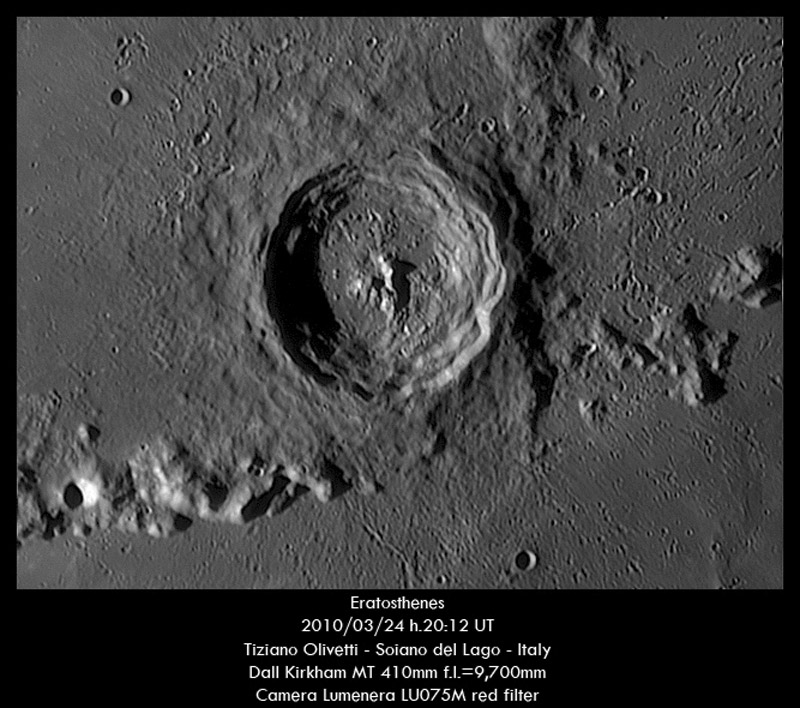Difference between revisions of "April 6, 2010"
| Line 3: | Line 3: | ||
<!-- ws:start:WikiTextHeadingRule:1:<h1> --> | <!-- ws:start:WikiTextHeadingRule:1:<h1> --> | ||
<!-- ws:start:WikiTextLocalImageRule:16:<img src="/file/view/LPOD-Apr6-10.jpg/132418517/LPOD-Apr6-10.jpg" alt="" title="" /> -->[[File:LPOD-Apr6-10.jpg|LPOD-Apr6-10.jpg]]<!-- ws:end:WikiTextLocalImageRule:16 --><br /> | <!-- ws:start:WikiTextLocalImageRule:16:<img src="/file/view/LPOD-Apr6-10.jpg/132418517/LPOD-Apr6-10.jpg" alt="" title="" /> -->[[File:LPOD-Apr6-10.jpg|LPOD-Apr6-10.jpg]]<!-- ws:end:WikiTextLocalImageRule:16 --><br /> | ||
| − | <em>image by [mailto:ph7_347@hotmail.com | + | <em>image by [mailto:ph7_347@hotmail.com Tiziano Olivetti], Italy</em><br /> |
<br /> | <br /> | ||
| − | LPOD has featured so many great images of Eratosthenes that I have nothing new to say, but Tiziano's image is too grand to pass up. Although the radiating ejecta and secondary craters on the mare floor are impressive, what catches my eye are the flat spots on the crater's floor. Is it impact melt? I would think not since melt is only preserved so long and Eratosthenes is perhaps twice as old as Copernicus. The way to tell is to check with higher resolution images. A Lunar Orbiter V [http://www.lpi.usra.edu/resources/lunarorbiter/frame/?5135 | + | LPOD has featured so many great images of Eratosthenes that I have nothing new to say, but Tiziano's image is too grand to pass up. Although the radiating ejecta and secondary craters on the mare floor are impressive, what catches my eye are the flat spots on the crater's floor. Is it impact melt? I would think not since melt is only preserved so long and Eratosthenes is perhaps twice as old as Copernicus. The way to tell is to check with higher resolution images. A Lunar Orbiter V [http://www.lpi.usra.edu/resources/lunarorbiter/frame/?5135 frame] shows that the apparently flat areas are not really fllat, but they are darker than the rest of the floor. So far, there doesn't seem to be a hyper-resolution LRO [http://wms.lroc.asu.edu/lroc#damoon image] of the flat spots. So lacking definitive evidence it is still possible to wildly speculate: the flattish, dark area is impact melt that has been eroded, broken and nearly lost all of its pristine character.<br /> |
<br /> | <br /> | ||
| − | <em>[mailto:tychocrater@yahoo.com | + | <em>[mailto:tychocrater@yahoo.com Chuck Wood]</em><br /> |
<br /> | <br /> | ||
<strong>Technical Details</strong><br /> | <strong>Technical Details</strong><br /> | ||
| Line 16: | Line 16: | ||
<br /> | <br /> | ||
<hr /> | <hr /> | ||
| − | <div>You can support LPOD when you buy any book from Amazon thru [http://www.lpod.org/?page_id=591 | + | <div>You can support LPOD when you buy any book from Amazon thru [http://www.lpod.org/?page_id=591 LPOD!]<br /> |
</div> | </div> | ||
---- | ---- | ||
===COMMENTS?=== | ===COMMENTS?=== | ||
| − | + | Register, and click on the <b>Discussion</b> tab at the top of the page. | |
Revision as of 17:18, 11 January 2015
Flat Out of Luck

image by Tiziano Olivetti, Italy
LPOD has featured so many great images of Eratosthenes that I have nothing new to say, but Tiziano's image is too grand to pass up. Although the radiating ejecta and secondary craters on the mare floor are impressive, what catches my eye are the flat spots on the crater's floor. Is it impact melt? I would think not since melt is only preserved so long and Eratosthenes is perhaps twice as old as Copernicus. The way to tell is to check with higher resolution images. A Lunar Orbiter V frame shows that the apparently flat areas are not really fllat, but they are darker than the rest of the floor. So far, there doesn't seem to be a hyper-resolution LRO image of the flat spots. So lacking definitive evidence it is still possible to wildly speculate: the flattish, dark area is impact melt that has been eroded, broken and nearly lost all of its pristine character.
Chuck Wood
Technical Details
See image bottom
Related Links
Rükl plate 21
COMMENTS?
Register, and click on the Discussion tab at the top of the page.



